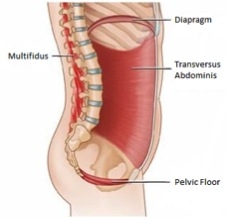Engage your core this winter!!
February 16, 2017
Many of us spend most of our time with our core disengaged, that's just the nature of the 21st century I'm sorry to say. A Physical Therapy friend and colleague of mine, Brandon Freeman at Portland Physical Therapy, and I had a recent discussion on core, lumbar disc and lower back injury. Yes, I know what you're thinking, do these guys actually talk about anything else? The answer is yes, but the majority of it is focused on our patients, education and continued learning! We readily agreed that many of us have weaker cores, which causes anterior pelvic tilt and forces our lumbar and lower thoracic spine into extension. Ok, why is that important you might ask? It's important because it puts chronic strain on the posterior portion of our discs, especially the lower we go in the lumbar spine. This puts us in a vulnerable spot, allowing us to become more prone to disc bulge and herniation.
You probably have heard someone, or even yourself say, I just bent over to pick something up and my back gave out, or I went to shovel my driveway and I couldn't move for three days. Well, it would appear that the particular incident of bending over or shoveling caused the disc hernation or lower back injury, but the reality is, it most likely started quite some time ago. Our discs are very strong and can handle tremendous axial (pressure straight down our spine) strain, yet when we change the angle of force on our discs, they can become very susceptibe and weaken over time. We've all heard of, or seen the waterfall eroding the dense rock over millions, so does our posture and ergonomics affect our discs over time, predisposing us to injury.

Ok, I get it, but how do I avoid it? We start by teaching patients to learn how to engage their core. Once they have accomplished this, we move onto posture. During postural and ergonomic training we teach patients to engage their core and perform posterior pelvic tilt to reduce extension and posterior disc pressure, improving spinal (disc) health. It's very imporant to learn to engage core and posterior pelvic tilt without overactivation of other muscle groups, such as pelvic floor, hamstrings, hip flexors, et cetera. We can then move towards more dynamic activities while supporting our spine and improving our overall posture and ergonomics. Most of us have chronically tight hip flexors due to improper posture and strain, so we notice amazing side effects such as reduced hip pain, lower back pain, pelvic and leg pain.
If you're at home and want to get started, I would advise you to speak to a professional who can teach you how to enage your core properly. I wish it was as easy one, two, three but the reality is, something as seemingly simple as standing up straight, isn't quite the over the counter prescription that you might think. A Physical Therapist, Chiropractor, Medical Doctor, Athletic Trainer or Personal Trainer should be able to give you the help you need. Many of us know or are a patient/client of one of the aforementioned and can squeeze some advice out of them! However, if you already are trained in core activation, then don't forget to engage your core when you're shoveling!!
Portland Chiropractic Neurology is the only Chiropractic Neurology practice in Southern Maine, conveniently located in Portland. Our doctors maintain specialties in Neurology with advanced degrees (fellowships) in Concussion and Brain Injury diagnosis and rehabilitation, Spinal and Orthopaedic diagnosis and rehabilitation as well as Vestibular rehabilitation. Our team also consists of Physical Therapists and Occupational Therapists, creating a multi-disciplinary approach. We utilize the latest advancements in technology and treatments to provide our patients with the best possible care. If you have questions, please contact us at 207-699-5600, or email at info@portchiro.com